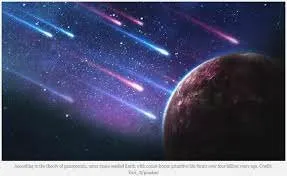
The idea of life raining down on our planet from space is called Panspermia (literally: universal origins of life). It will probably come as a complete surprise to many conservative thinkers that the idea of life tumbling to Earth from space is not totally derided in broader scientific circles. The prestigious journal Scientific American has published several serious articles on this topic and visiting the site of the even-more-famous journal Nature, I found 38 entries on
the topic.
The idea was launched as a plausible scientific theory by none other than Sir Fred Hoyle, the man who coined the derisive term “the Big Bang”! In collaboration with his pupil, Sri Lankan mathematician and astronomer Chandra Wickramsinghe, Hoyle argued that life, at least in part, could have originated from extraterrestrial sources. The two even went so far as to propose that certain historical plagues were extraterrestrial in origin, caused by alien microbes raining down on Earth. Well, nobody can prove that isn’t true! If it did happen, those organisms might have survived and be here with us now. To my surprise, I learned that in a lecture delivered at Harvard University almost three decades ago, Nobel laureate Francis Crick, co-discoverer of DNA, declared that he had become disenchanted with the view that life arose on Earth. Instead, he too espoused Panspermia and proposed that the seed of life could have been an extraordinarily resistant spore of the kind produced by Bacillus subtilis and related bacteria, capable of enduring in deep space without air and water.

In response, Matthew Meselson pointed out that, if this were so, surely the extraterrestrial civilization would have sent a message or code in the spore. If only mankind was able to sequence DNA, he wistfully conjectured, then we could learn the secret of the Universe from the nucleotide sequence of the contemporary genome of the spore-forming bacterium. Maybe the SETI receivers, looking for radio signals, are going about it the wrong way and the DNA of life is the interplanetary equivalent of the Rosetta Stone, which allowed us to translate many early Earth languages
Of course this goes against the grain of orthodox science (Wikipedia remarks, almost coyly, that the idea of Panspermia is “essentially contra the scientific consensus”). Well, we all know what that means, don’t we? Hitting a raw nerve with the diehards is not proof that a hypothesis is wrong or could not work.
The Panspermia hypothesis assumes that small organic grains, or spores, or chunks of organic matter, could remain viable after travelling immense distances through space and still be capable of replicating themselves. No problem with that.
The real test will be finding organic life forms, or at least proto-life substances, further out in space, say on an asteroid, in the tail of a comet, or on the surface of one of the many moons found in the Solar system. The more of it is out there, the more it is likely to be interplanetary or interstellar in origin.
Now scientists have found a significant organic molecule in the Sagittarius B2 system, which lies some 27,000 light-years from Earth. This carbon-based molecule is interesting because it has a branched structure, suggesting that it’s probably isopropyl cyanide and that’s important, because isopropyl cyanide is often found in molecules associated with life, such as amino acids. As a star forms, it produces isopropyl cyanide in an early part of its formation process.